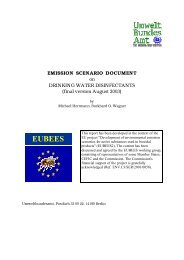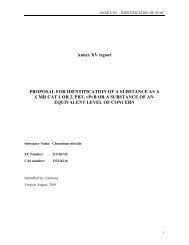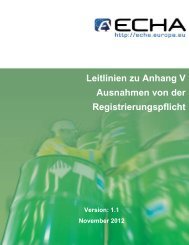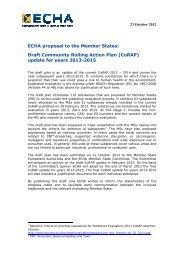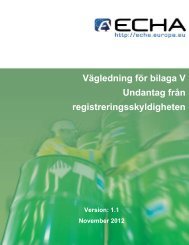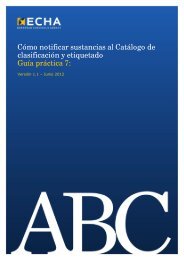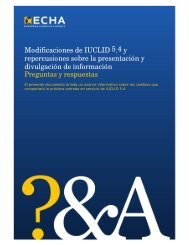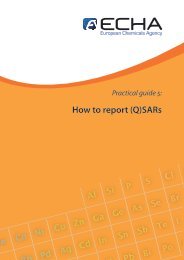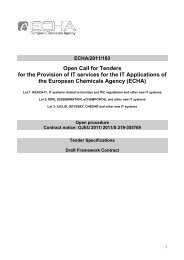Strategy For Limiting Risks Human Health Draft of ... - ECHA - Europa
Strategy For Limiting Risks Human Health Draft of ... - ECHA - Europa
Strategy For Limiting Risks Human Health Draft of ... - ECHA - Europa
You also want an ePaper? Increase the reach of your titles
YUMPU automatically turns print PDFs into web optimized ePapers that Google loves.
Scenario 2: Use <strong>of</strong> cryolite in the aluminium industry<br />
<strong>For</strong> assessing inhalation exposure levels and deriving concern measurements for anode<br />
changing (9.5 mg/m3 dust (geometric mean)) were taken. With cryolite beeing a fraction <strong>of</strong><br />
21 % and taking all information into account, 2 mg/m3 cryolite was regarded to represent the<br />
reasonable worst case for cryolite in workplace air in the aluminium industry.<br />
This value is significantly higher than the envisaged OEL. Still, it is supposed that within the<br />
aluminium industry it is practical to comply with an OEL in the order <strong>of</strong> magnitude <strong>of</strong> 0,1<br />
mg/m 3 , at least as long as routine processes are concerned. Measured data provided for the<br />
RAR seem not specific enough to describe the state-<strong>of</strong>-the-art <strong>of</strong> different tasks and at<br />
different sites for the production <strong>of</strong> aluminium. Neither seem the default values derived from<br />
the EASE model to fully reflect exposures in the aluminium industry. .<br />
<strong>For</strong> the production <strong>of</strong> aluminium, cryolite is part <strong>of</strong> a smelter bath contained in “pots”<br />
(electrolyses furnaces). Workers in aluminium smelters handle cryolite only for rare occasions<br />
<strong>of</strong> charging extra cryolite on the pots. Releases from the pot to room air are caused when the<br />
hoods are removed for renewal <strong>of</strong> anodes, for relining the pot, for tapping aluminium or<br />
excess cryolite and for adding bath constituents to the bath. The acute risks resulting from<br />
possible release <strong>of</strong> HF during the aluminium smelter are vital and higher than those from<br />
cryolite. Old pots and used anodes are taken out <strong>of</strong> service after 5 to 7 years <strong>of</strong> operation.<br />
In 2003 the Norway project “Survey <strong>of</strong> occupational exposure <strong>of</strong> importance in developing<br />
occupational asthma by production <strong>of</strong> primary aluminium “stated that the main contribution to<br />
the occupational exposure in this industry is caused by episodes, typically short timed and<br />
with high concentrations, (Skaugset, 2008). Taking into account the high acute risks<br />
associated with the hydr<strong>of</strong>luoric acid which is present in the smelter process, it can be<br />
assumed, that on company level technical and organisational measures are taken to rigorously<br />
control exposures during every stage <strong>of</strong> the production process. It may be assumed, that the<br />
control <strong>of</strong> cryolite to a very low and safe level is practical and will not cause any extra<br />
measures or costs.<br />
Scenario 3: Use <strong>of</strong> cryolite in other industries (e.g. production <strong>of</strong> abrasives, glass-<br />
ceramic industry, foundries)<br />
The exposure to cryolite mainly takes place when solid cryolite is handled for inclusion into a<br />
matrix (critical tasks: weighing, dosing, charging or mixing). The use <strong>of</strong> grinding discs or<br />
abrasives containing cryolite is assessed separately in scenario 4.<br />
Measured data and exposures assessed with the EASE model are in the same order <strong>of</strong><br />
magnitude. <strong>For</strong> Risk Assessment the reasonable worst-case values were taken forward (10<br />
mg/m 3 ) which are significantly higher than an envisaged OEL.<br />
<strong>For</strong> assessing the practicality <strong>of</strong> an OEL it has to be taken into account, that the typical values<br />
which are achievable under the conditions <strong>of</strong> good practice will be significantly lower than<br />
worst case exposures.<br />
• A study (Marquart 1999) showed, that for dumping <strong>of</strong> a variety <strong>of</strong> powders into mixers<br />
exposure levels <strong>of</strong> inhalable dust <strong>of</strong> 1,9mg/m 3 (1.9 to 27.6 mg/m 3 ) and full-shift exposures<br />
<strong>of</strong> 0,8mg/m 3 (0.8 to 12.1 mg/m 3 ) can be achieved. The study was performed in in<br />
41






